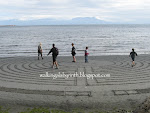Labyrinths and Liminality: Walking a Labyrinth is like accepting an invitation to pray, meditate, contemplate, dream, celebrate or play; a place to find inspiration, satisfy a curiosity, examine metaphor, mythology or simply, a place to explore liminal space: a 'betwixt and between' place. See my Profile for a full description of this Blog . . . Background picture on my Blog is from the posting: Thursday, August 19, 2010.
Copy write Notice
Copyright © 2010 - 2024. All rights reserved. The material on this site: pictures or written material, may not be published, broadcast, rewritten or redistributed in any form.
Peace and Blessings on your path.
Sunday, April 18, 2010
Connecting with nature . . . experiencing wonder
I have grown to appreciate Kye Bay on Vancouver Island for the opportunity it offers to connect with nature.
In early April I drew a labyrinth at Kye Bay. I was in the process of photographing it, when a eagle flew by me and landed on a tree behind the labyrinth. The eagle sat perched in the tree while I completed my walk.
Several times I stopped to look at this bird of prey . . . what most caught my attention then and still, was the relationship between the eagle and the two crows sitting on a branch above the eagle. Why two crows and not more? Why were they above the eagle and not below? Were the crows a couple or were they acting together for the benefit of other crows - why??
I also wondered why I often see crows pursuing eagles, yet, they will build a nest next to a tree with a pair of eagles nesting in it.
Subscribe to:
Post Comments (Atom)
Followers
About Me

- walking a labyrinth
- Walking a Labyrinth is like accepting an invitation to pray, meditate, contemplate, dream, celebrate or play; a place to find inspiration, satisfy a curiosity, examine metaphor, mythology or simply, a place to explore liminal space: a 'betwixt and between' place. . . Victor W Turner has described liminality as "a fructile chaos, a storehouse of possibilities, not a random assemblage but a striving after new forms and structures, a gestation process." Labyrinths are drawn on the foreshore, betwixt the nearshore and the backshore, between the low and high water marks to present liminal space as a physical location. Labyrinths may also be drawn during liminal time: dusk or dawn and/or solstice or equinox. The flags surrounding the labyrinth are used for a couple reasons: first they help people find the labyrinth at Spanish Banks. Next, they are used to create a natural acoustic environment. This auditory experience or sound scape ecology is intended to alter the perception and/or the perspective of visitors while they are walking the labyrinth. For information please email: walkingalabyrinth@gmail.com


No comments:
Post a Comment